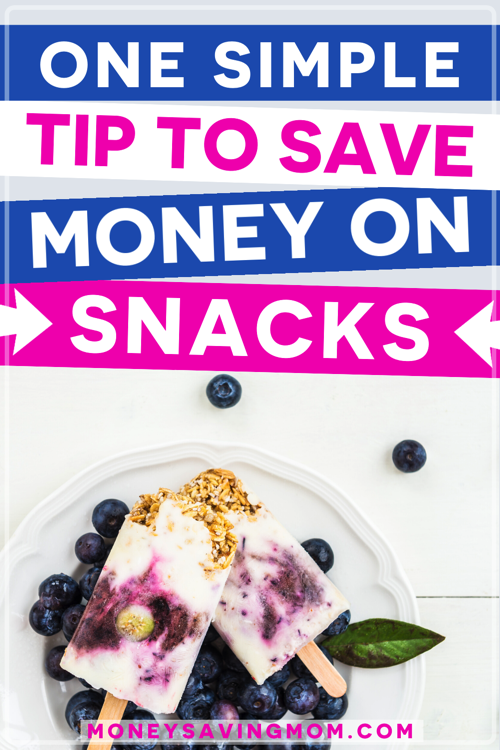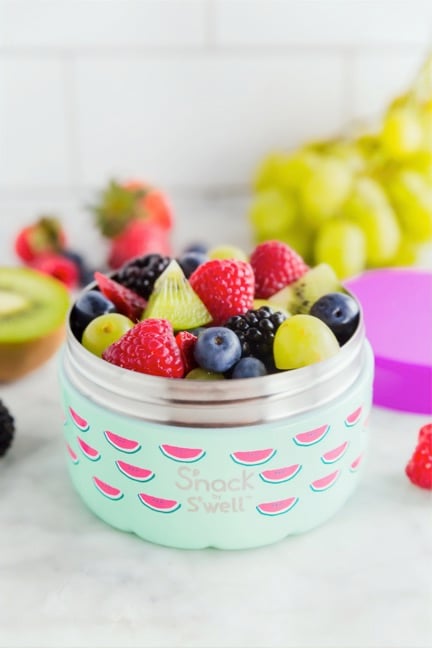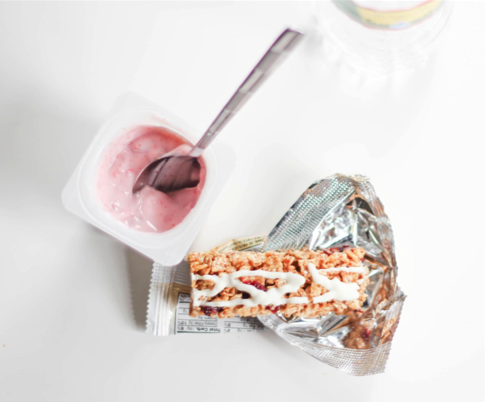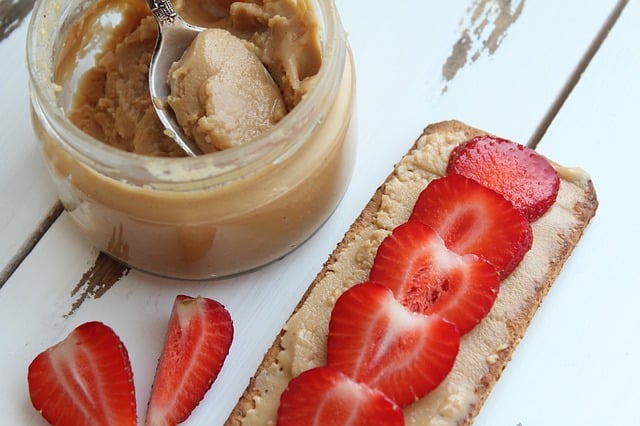Does your family love snacks? This is such a simple tip to save money on snacks!
{Psst! Check out how making your own snacks can save you over $100 per year! And read about how we afford snacks for our kids on a tight grocery budget.

Guest post from Margaux of A Momma and Her Flock:
We are a snacking family. Typically, we find a way to squeeze four snacks into the lunchboxes on top of the main lunch item.
But a healthy snacking appetite can be bad news for the grocery bill. That is why I started calculating the cost per snack serving, so that I could try to find cheaper alternatives.
The True Cost of Snacks:
I like to believe that I am reasonably thrifty with my grocery spending, but some snack habits can catch me off guard.
For instance, grapes and Honeycrisp apples both cost $2 per pound, but my husband eats more grapes at a time than the equivalent of a single apple.
To calculate the ‘cost per serving’ of a snack, I base it on the actual amount I or my family would eat in a sitting. A “serving” is what fills up the person eating the snack, not necessarily the recommended portion on the box.
One snack my husband likes to devour after his morning workout is hard-boiled eggs. Since he eats three eggs at a time, I divide the cost of 12 dozen eggs to get $0.37 per 3-egg serving.
My personal rule of thumb is to keep any individual snack under $1 per serving. The closer to $0.50 or less per serving, the better!

How to Minimize the Cost per Serving:
If you can minimize the cost per serving on snack foods, you can save quite a bit of money!
With this cost per serving goal in mind, here are 3 ways I satisfy my family’s “snack tooth” without breaking the bank…
1. Find the most filling snacks.
Occasionally I find myself munching through an entire bag of chips. Some snacks are not as good at satisfying hunger.
I search for snacks high in fiber and protein that will still appeal to our taste. When comparing items in the grocery store, I ensure there are at least 150 calories and 3 grams of protein per serving.
Nutritionists recommend pairing proteins with carbs for the ultimate filling combo – like grapes and cheese, or apple slices and peanut butter.
When I eat denser and more filling snacks, I find that I need fewer snacks throughout the day — which ultimately saves money.

2. Avoid pre-packaged snacks.
Many foods are now available in snack packaging, but the convenience comes at a high markup. Think of mini hummus cups, snack cracker packs, pre-cut cheese squares, and more.
The difference in cost is striking in the example of homemade versus pre-packaged peanut butter snack cups.
JIF To-Go peanut butter is priced at about $0.40 per 1.5-ounce cup. If I make my own to-go cups by spooning out 1.5 ounces from a full-size jar of JIF peanut butter, each serving costs only $0.24 for 1.5 ounces. And if I use store-brand peanut butter instead of JIF, the serving cost drops to $0.14 for 1.5 ounces. (Note: These prices are based off what I find in my region: $3.19 for an 8-count pack of JIF To-Go, $2.39 per full size jar of JIF, and $1.50 per jar of store brand peanut butter.)
You can easily make single-servings on your own by dividing a regular size item into individual containers.
For reusable containers, I like the Rubbermaid Brilliance storage containers. Alternatively, disposable containers can be purchased in bulk from a store like Gordon Food Service.
If you are unsure about finding time to make your own snack packs or wash the resulting containers, try starting out with one of these simple solutions:
- Cut your own cheese slices or cubes from a block
- Slice your own salami or pepperoni from a large roll
- Dish out peanut butter, hummus, yogurt, or crackers from a full-size container

3. Mix in cheaper substitutes
I go through seasons where I eat primarily dairy-free, and the challenge is that the dairy alternatives are more expensive.
The way I justify purchasing dairy-free yogurts, ready-made snacks, and other items above my target cost per serving is by mixing in low-cost substitutes.
For my husband and daughter who enjoy Greek yogurt, I find that cottage cheese is less than half the price for the same calorie and protein content. So sometimes we forgo a day of yogurt and eat cottage cheese instead.
Also, consider swapping out these pricey snacks:
- Almond butter -> Peanut butter
- Greek yogurt -> Cottage cheese
- Berries -> Apples, Bananas, or Oranges
- Bell peppers -> Carrots or Celery sticks
- Rice crackers -> Tortilla chips
Start Saving!
I recommend doing a personal snack-spending inventory this week.
Calculate the ‘cost per serving’ of the most popular snacks in your household. Do not worry if the cost is higher than you thought. Set a cost target and work on lowering snack spending gradually.
Want a jump start on snack savings? Try these ideas:
- Over 25 Frugal & Healthy Snack Ideas for Kids
- 10 Healthy & Cheap Vegan Snacks for Kids
- Quick & Healthy High Protein Snack Ideas
- Healthy Snacks Under $1 per Serving
Margaux is a full-time mom, wife, and engineer who firmly believes there are not enough hours in a day. She is a fan of schedules, to-do lists, and mom hacks. Above all, she tries to keep God at the center of everything. She writes at A Momma and her Flock.
Psst! Crystal here! Need more help saving on groceries? Go here and sign up (it’s free!). I’ll send you my 10 Easy Ways to Cut Your Grocery Bill By $50.


I discovered recently that it’s cheaper (at least using Walmart brand) to hand my kid a cheese slice than a cheese stick. It’s a little less cheese but since my kids are younger and they are usually also eating fruit the smaller portion is fine. I don’t have time to slice cheese but the pre-sliced sandwich cheese (cheddar is what we use) was cheaper than cheddar sticks.
Thanks for the tip! -Jordan, MSM Team
I really appreciate this post. I was wondering if you could post more of the cheaper ideas as a place for me to start…like the part about subbing bananas, apples, oranges for berries….? I guess an ultimate cheapest snack list would be helpful too:)
Another easy, high protein snack is homemade nut butter. You can use any nut or seeds (we tried walnuts). Roast at 350 degrees for 8-12 minutes, then grind in a food processor. 1 cup of whole nuts equals 1/2 nut butter. No additives and much more affordable!
That’s a great tip! Thanks for the suggestion! -Jordan, MSM Team
And don’t be afraid to serve your snacks a little differently! I bought some popsicle molds on clearance at the end of last summer for a quarter each. I decided to use them to make frozen yogurt pops.
While my kids would normally devour a single yogurt cup per person, I can get 3 yogurt pops out of one of those cups! The kids will only eat 1 yogurt pop because it takes them longer than just eating a regular yogurt cup with a spoon. That stretches my yogurt out 3 times as much!
Great tip!